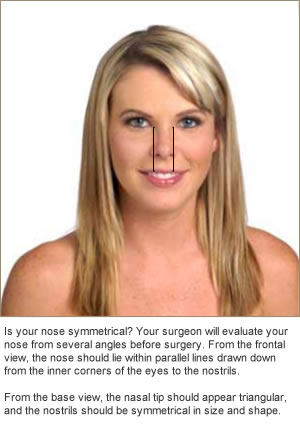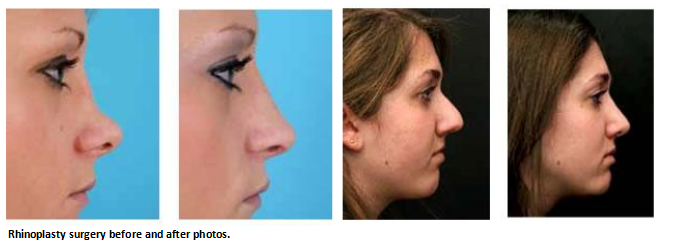Nasal Cosmetic Surgery
Understanding Rhinoplasty
Every year, half a million people seek consultation for enhancement of the appearance of their nose. Whether it from trauma, aging, natural development, prior surgery, or other causes, the appearance of the nose can be the cause of considerable concern. In many cases, there is the additional goal of improving breathing. As the nose occupies a central position on the face, the size and shape of the nose has a great impact on an individual’s appearance and often a person’s self esteem.
My nose was long and went down at the tip. When I smiled, it looked long and wide. I didn’t want a major change, and my surgery resulted in only a subtle improvement. Some people didn’t even notice the change, but it made a big difference to me. It made me feel a lot better about myself.
– jennifers., age 16

Understanding the Surgery
The term rhinoplasty is derived from the German “rhinoplastik” which means “changing the shape of the nose”. The technique involves first accessing the bone and cartilage elements of the upper nose. This is achieved through incisions made inside the nose, where they are invisible (Closed Rhinoplasty). In some cases, an incision is made in the area of skin separating the nostrils (Open Rhinoplasty). Next, the underlying bone and cartilage is reduced, augmented or rearranged to create a newly shaped structure. For example, if the bridge of the nose has a prominence, this can be reduced to yield a more pleasing profile. If any portion of the nose appears disproportionately small, cartilage or soft tissue grafts can be placed to create better harmony. This is sometimes referred to as an Augmentation Rhinoplasty, which is more common in some ethnic groups that tend to genetically have smaller structures in their nose. Nasal Tip surgery is often also considered to further improve the overall appearance of the nose. The angles of the nose in relation to the upper lip or the forehead and the width of the nasal tip can be altered by further sculpting the nasal tip support structure.
The tissues are then redraped over the new frame and the incisions are closed. A small plastic splint is applied to the outside of the nose to minimize swelling and to help maintain the new shape while the nose heals. Soft, absorbent material may be used inside the nose to maintain stability along the dividing wall of the air passages called the septum. Alternatively, soft nasal supports that permit nasal breathing post-operatively can be placed.

Most patients report little or no pain after nasal surgery, and any discomfort is easily controlled with mild pain medication.
What to Expect After the Surgery
Upon completion of the surgery, you will be monitored in the post anesthesia recovery area until you feel well enough for discharge home. The majority of patients do not experience any significant pain, however, analgesic medications can be given as needed for post operative discomfort. Whether packing is placed in the nose or not, most patients will comment that their nasal breathing is limited in the first few days after surgery. This is a result of internal swelling that improves as the swelling subsides. Your face will feel puffy,especially the first day after surgery. Some patients develop swelling and/or bruising around the eyes. This generally starts to subside in the first 2-5 days after surgery. Cold compresses will help minimize and reduce the bruising and any discomfort. Absorbable sutures are generally used inside the nose and do not need removal. Any external sutures, if required, are removed in 5-8 days. Nasal dressings and splints are also removed at 5-10 days after surgery.
It is imperative that you follow your surgeon’s post operative instructions. Keeping your head elevated will minimize swelling. It is important not to blow your nose and to avoid any impact to the nose while the structures inside and out are healing. Activities such as heavy lifting, excessive exertion, sun exposure or any activity that would increase the risk of injury should be avoided. If you wear glasses, you must be careful not to exert excess pressure on the bridge of the nose. Tape and other devices are sometimes used to permit wearing glasses without stressing the area during healing. Make sure to ask your surgeon how long these restrictions are in place so you are well prepared to plan your recovery period.
Follow-up care is crucial to success in rhinoplasty. Any concerns regarding your post operative course such as excess bleeding, unexpected swelling, fever or significant pain should be reported to your surgeon immediately. It is essential that you keep your follow-up appointments with your surgeon. As your healing is being monitored, there may be techniques such as massage, use of nasal sprays or even small injections of cortisone like medications that can further enhance the desired result.
Insurance does not generally cover surgery that is purely for cosmetic reasons. Any component of the surgery aimed at improving nasal function or correcting any traumatic nasal deformity may be partly or entirely billed to insurance. Discussion with your surgeon’s staff and your insurance carrier will help determine your eligibility.
With proper analysis, realistic patient expectations and the skills of a qualified facial plastic surgeon, rhinoplasty is a very rewarding procedure for both patient and surgeon alike.
Even a minor correction can make a difference in overall facial harmony.